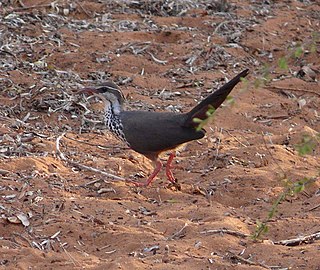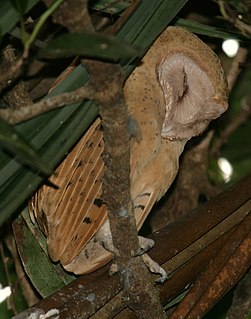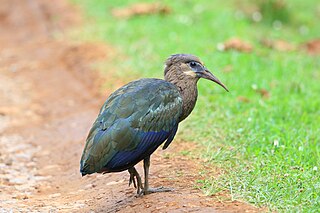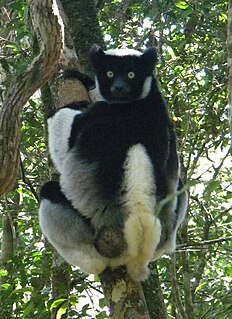
The mesites (Mesitornithidae) are a family of birds that are part of a clade (Columbimorphae) that include Columbiformes and Pterocliformes. They are smallish flightless or near flightless birds endemic to Madagascar. They are the only family with more than two species in which every species is threatened.

The Madagascar lowland forests or Madagascar humid forests are a tropical moist broadleaf forest ecoregion found on the eastern coast of the island of Madagascar, home to a plant and animal mix that is 80 to 90% endemic, with the forests of the eastern plain being a particularly important location of this endemism. They are included in the Global 200 list of outstanding ecoregions.

The red owl is an owl in the barn owl family Tytonidae. It is also known as the Madagascar red owl, Madagascar grass-owl and Soumagne's owl. It is a rare resident of Madagascar that was virtually unknown from its discovery in 1876 to its rediscovery by researchers from the World Wide Fund for Nature in 1993. It is currently listed as vulnerable because of habitat loss, but recent studies have determined it may have a wider range than first believed, though further research in distribution and ecology is required. It has possibly been overlooked because of its close resemblance to the closely related barn owl.

The helmet vanga is a distinctive-looking bird of the vanga family, Vangidae, and is classified in its own genus, Euryceros. It is mainly blue-black, with rufous wings and a huge arched blue bill. It is restricted to lowland and lower montane rainforests of northeastern Madagascar. Its diet is composed of invertebrates, predominantly insects. The species is threatened by habitat loss.

The nankeen night heron is a heron that belongs to the genus Nycticorax and the family Ardeidae. Due to its distinctive reddish-brown colour, it is also commonly referred to as the rufous night heron. It is primarily nocturnal and is observed in a broad range of habitats, including forests, meadows, shores, reefs, marshes, grasslands, and swamps. The species is 55 to 65 cm in length, with rich cinnamon upperparts and white underparts. The nankeen night heron has a stable population size, and is classified as a species of least concern by the International Union for Conservation of Nature (IUCN).

The Malagasy or striped civet, also known as the fanaloka or jabady, is an euplerid endemic to Madagascar. It is the only species in genus Fossa.

The white-breasted mesite is a ground-dwelling bird endemic to Madagascar. One of three species in the mesite family, Mesitornithidae, it is classified as vulnerable by the International Union for Conservation of Nature (IUCN). It has a small population and is restricted to five sites in the north and west of the island, and one in the east.

The subdesert mesite is a ground-dwelling bird endemic to Madagascar. It is one of three species in the mesite family Mesitornithidae, and is restricted in distribution to a small low-land region in southwest Madagascar.

The Australian painted-snipe is a medium-sized, long-billed, distinctively patterned wader.

Henst's goshawk is a species a bird of prey in the family Accipitridae. It is a large, diurnal bird endemic to the island of Madagascar. It is an obligate forest species that occurs at very low densities on the island and is rarely seen. It can only occupy the primary and secondary forests found within the island. Its natural habitats are subtropical or tropical dry forest, subtropical or tropical moist lowland forest, subtropical or tropical moist montane forest, and plantations.

The Madagascar plover, also known as the black-banded plover, is a small monogamous shorebird in the family Charadriidae, native to western Madagascar. It inhabits shores of lagoons, coastal grasslands, and breeds in salt marshes. These plovers mainly nest in open grassland and dry mudflats surrounding alkaline lakes. The species is classified as vulnerable by the IUCN because of its low breeding success, slow reproductive rate, and weak adaptation to increasing habitat loss, leading to declining population numbers.

The pallid cuckoo is a species of cuckoo in the family Cuculidae. It is found in Australia, with some migration to the islands of Timor and Papua New Guinea. It is between 28 and 33 cm in size, with distinctive markings such as a dark bill, a dark eye with a gold eye-ring and olive grey feet which differentiate it from other cuckoos. The pallid cuckoo is similar in appearance to the oriental cuckoo, with barred immature pallid cuckoos being often mistaken for oriental cuckoos.

The olive ibis is a species of ibis native to dense tropical forests in central Africa. Between 65 and 75 cm in length, it is a small ibis with olive plumage displaying a iridescent sheen. Four subspecies are recognized.

The Sakalava rail is a species of bird in the family Rallidae. It is endemic to western Madagascar. This bird is small with brown upperpart feathers, grey underparts, a yellow bill and red legs.

Archbold's newtonia is a species of bird in the family Vangidae. It is endemic to Madagascar. Its natural habitats are subtropical or tropical dry forests and subtropical or tropical dry shrubland. The birds have a greyish brown back and tail, with a rufous forecrown and a buffy white belly, throat, and undertail coverts. They have a conspicuous rufous eye-ring, accompanied with a black bill and pale yellow eyes. The species is sexually monomorphic, and there is no major difference between the sexes. There is no breeding plumage for the males.

Mesitornis is a genus of birds in the family Mesitornithidae. Its two members. the white-breasted mesite and the brown mesite are endemic to Madagascar and both species are classified as vulnerable on the International Union for Conservation of Nature (IUCN) Red list of Threatened species. A third species is also called a mesite, is the single member of the genus Monias.

The rufous-headed ground roller is a species of bird in the ground roller family, Brachypteraciidae. It is endemic to Madagascar. There are currently five known species of ground rollers. Four of these species live in the eastern and central highland humid forests. Unlike the four other species, the fifth species lives in the dry southwestern spiny bushes of Madagascar. The Atelornis crossleyi species of the ground rollers lives with most of its family in humid forests. The International Union for Conservation of Nature considers the bird to be near-threatened because, although it is present in a number of protected areas, it is hunted for food and the forests in which it lives are threatened by slash-and-burn cultivation. The bird's scientific name commemorates Alfred Crossley who collected mammals, birds, butterflies and moths in Madagascar and Cameroon in the 1860s and 1870s. Many of these are in the Natural History Museum, London.

Zahamena National Park is a national park of Madagascar. Established in 1997, it covers an area of 423 square kilometres (163.32 sq mi) out of a total protected area of 643 square kilometres (248.26 sq mi). It is part of a UNESCO World Heritage Site, Rainforests of the Atsinanana, inscribed in 2007 and consisting of 13 specific areas located within eight national parks in the eastern part of Madagascar. In 2001, Bird Life International assessed avifauna of 112 species of which 67 species are exclusively endemic to Madagascar.

Tsitongambarika is a lowland forest in southern Madagascar. The area supports many rare species of amphibians, birds, lemurs and reptiles; many of which are endemic. In 2001, the site was designated as an Important Bird Area by BirdLife International and in 2015, an area of 600 km² received environmental protection by the government. The reserve is the recipient of monies raised by the 2016 Rutland Birdfair.



















